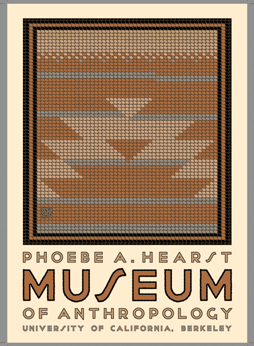
Click on image for detail
(238) Phoebe A, Hearst Museum of Anthropology:
Edition of 1578 of which 225 copies are signed 1-125, 27 copies are signed A-Zz as artist's proofs. Two sets of progressives.
September 23, 2015
17- 3/16" x 24"
Seven Colors
Paper: Strathmore 88 Duplex
Influence: Northern California (Yurok) Native American basket
Client: Phoebe Apperson Hearst Museum of Anthropology, UC Berkeley
1-125: Saint Hieronymus Press
126-225: Hearst Museum of Anthropology
A-Zz: Artist's own use
Dedication copies:
How can you tell if something is well made, when you don't know anything about it? Professor David Pye, of the University of London, wrote two influential books on design and workmanship: "The Nature and Aesthetics of Design," (1964) and "The Nature and Art of Workmanship" (1968), which address this question.
What you do is this: look for gratuitous elements that in no way improve the function of the object, but simply make it prettier. What these do is increase the cost of manufacture so much that a similar, cheaply made object would be rendered ridiculously costly to no purpose. Think of the beautiful engraving and engine turning hidden away on the mechanism of a fine, jeweled, mechanical watch; a cheap watch cannot possibly have these finishing touches, and likewise a cheap watch will not tell good time nor will it last for generations. A deep, mirror-like paint job on a cheap car would make the whole car cost far too much. Such a paint job on a Lamborghini hardly increases the price at all. Therefore, simply by looking for a fine paint job on a car, or beautiful engine turning and engraving on a watch, you can, without knowing anything at all about watches or cars, tell the really good ones from the outwardly similar, but cheaply made.
Another aspect of gratuitous embellishment is simply the pride and pleasure the craftsman takes in his work. The weaving of the Native California basket that this poster is based upon shows a non-weaver that this is a good basket; that it is not only a basket that will hold and carry well and stand up to long use, but that the weaver was proud of her work, and wanted it to be valued not only for its usefulness, but for its beauty. Strangely enough, the basket is no longer valued as a basket per se, but as a beautiful object and as a testimony to the culture that made it.
Lastly, every craftsman works not only for today, but for tomorrow. They do good work not only for the pleasure of working, but make every piece as an advertisement for themselves. "This basket is beautiful; far more beautiful than it has to be, to tell you who know nothing about baskets that it is a good basket. Furthermore, I make baskets and I want to make more baskets, so when you look at this basket, think also of the woman who made it."